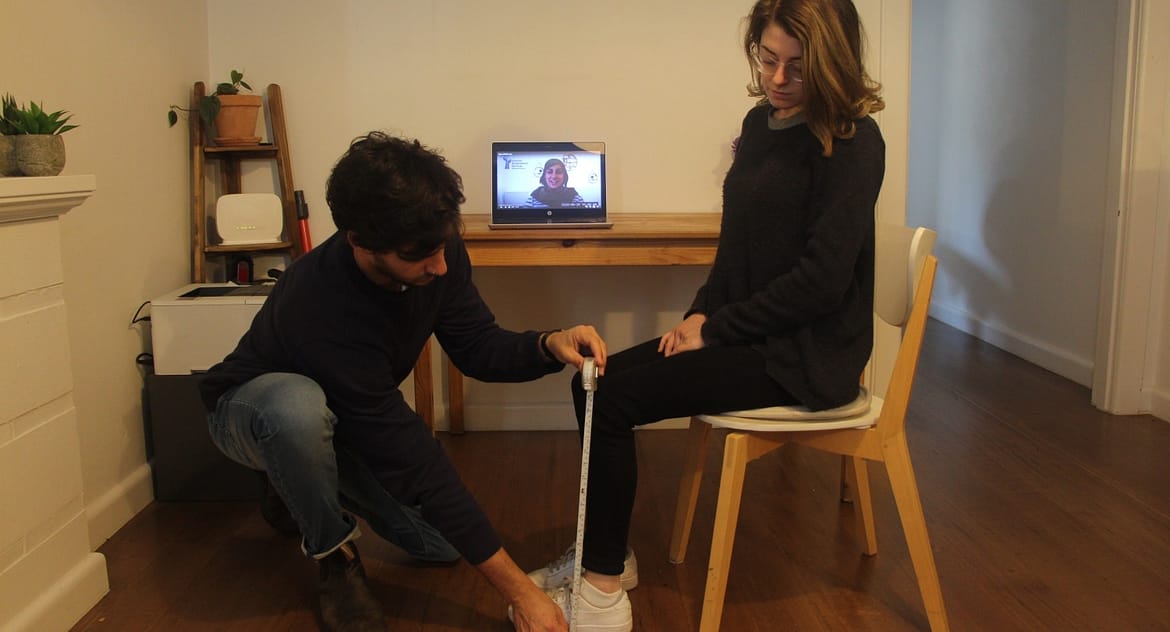Article by Ana Brown, Lead Allied Health Researcher.
“Never waste a crisis” were wise words spoken by our Allied Health Leader, Natalie Pribil, in March 2020.
I don’t think even she realised the impact those four little words would have on our occupational therapy practice for the coming months.
The ramifications of a social lockdown have been devastating – emotionally, physically and mentally for all, particularly those living with disability. It only magnified the unconscious privilege of the able-bodied members of society who have been scrambling for essentials at the supermarket.
Most people who are not healthcare workers wouldn’t consider how people living with acquired brain injury in the community are going to safely buy their groceries during a social lockdown, let alone how they are going to be assessed for their wheelchairs. But the occupational therapy team at Independent Rehabilitation Services (IRS) set to work on doing just that.
IRS is a multidisciplinary private practice consisting of occupational therapists, physiotherapists and speech pathologists based in Ashburton, Victoria. The clinicians are specialised in neurological and general rehabilitation for people living in the metropolitan and suburban community of Melbourne. IRS was founded by a visionary physiotherapist, Kate Phillips, in 1999.
Over the last 20 years, IRS has grown into one of the primary community rehabilitation services for people receiving NDIS, TAC and Workcover support. In that time, numerous policies and procedures were developed and refined for all scenarios imaginable: risk situations, complex cases and mental health. But there was no pandemic policy.
One of IRS’s values is leading change, and with Kate passionate about research and evidenced-based practice, this enabled the team at IRS to lead change during a world-wide pandemic, an unforeseeable scenario back in 1999. The journey of developing this tele-wheelchair assessment resource was three-tiered.
First was to survey our staff and understand how confident they felt in facilitating a wheelchair assessment through telehealth as a service model. Not surprisingly, most reported no prior experience in this and not much confidence to trial it. Video recordings were identified by the team as the preferred teaching modality.
Secondly we conducted a scoping review to determine what the literature could tell us about providing tele-wheelchair assessments. We found 92 papers, with only three meeting our inclusion criteria that could be used as recent evidence to inform our educational video.
Thirdly, we scoured the internet for any prior recordings on how to practically conduct a tele-wheelchair assessment and, to our surprise, found only two, which were short and not overly informative.
With limitations in the literature and time pressure as key factors, we set to work in developing two tele-wheelchair education videos: one to demonstrate how to conduct a postural assessment through telehealth, and the other on how to conduct a seating assessment with a paraprofessional supporting the client (in this case a wheelchair technician from Linds Rehabilitation in Melbourne).
Our ‘client’, Shannon Rothschild, is an occupational therapist and one of the IRS Telehealth Champions, and the occupational therapist was acted by Ana Brown, the Lead Allied Health Researcher at IRS. To remain as authentic and natural as possible in the videos, nothing was scripted or rehearsed. This allowed for realistic problem-solving that our occupational therapists would likely encounter.
These practical ‘how to’ videos have been embedded into a PowerPoint presentation which details the results from the scoping review as strategies on how to optimise the tele-wheelchair assessment.
These include:
Human and Communication Factors
- Support person: Organise the appointment so that a paraprofessional (e.g. friend, relative, support worker) will be with your client to assist with the measurements. The most ideal scenario would be a physiotherapist.
- Placement: Encourage the client and support person to be in view of the camera throughout the session.
- Swap photos: Send reference photos to the support person and receive asynchronous images of the client to inform the postural assessment.
- Timing: Sometimes a pause longer than usual is required after asking a question due to audio delay. Be aware and avoid talking at the same time. Consider your audience and how much time they will need to process information and complete the measurements.
Environmental and Equipment Factors
- Lighting: Client and clinician locations should have adequate lighting
- Sound: The microphone should be located near the client. A separate microphone, to be attached to the clothing of the client, should be considered.
- Clothing: Consider contrast in clothing for visual ease (e.g. light coloured wall, dark coloured wheelchair, light coloured clothing)
- Tape measures: Have a tape measure to demonstrate to the paraprofessional of how to measure.
- Assessment: Have your assessment document printed and prepopulated where possible
Incorporating these optimisation strategies can assist in reaching the best outcomes for clients receiving their wheelchair assessment through a telehealth platform. Tele-wheelchair assessment and interventions using these strategies have rendered similar satisfaction ratings for clients as face-to-face wheelchair intervention and assessments.
It is reported in the literature that clients are as likely to have their goals met through tele-wheelchair assessment as seen face-to-face². However, where possible, use synchronous means of conducting the tele-wheelchair assessment as this provides more information than asynchronous assessment alone. This does not mean that photos or pre-recorded videos are not sufficient to conduct a thorough assessment.
Developing this educational resource has been an interesting and novel experience given the context in which it was required. What we have learnt in this short space of time is difficult to express in just two pages, which is why IRS is presenting the results at the Virtual OT Exchange Conference in September 2020.
IRS has thrived in this scenario of leading change and continues to be excited to support other occupational therapists across the country in optimising clients’ capacity to engage in their rehabilitation through tele-wheelchair assessments, during this pandemic, and beyond.
About the author
Ana Brown has worked in the field of neurorehabilitation for over a decade. At IRS, Ana is the Lead Allied Health Researcher, Occupational Therapy Deputy Team Leader and is passionate about evidence-based practice. Ana is also a PhD Candidate at La Trobe University studying the conceptualisation and utilisation of sensory modulation interventions in the field of acquired brain injury rehabilitation.
1 Fichten, Catherine S. and Lefebvre, Genevieve. 2004, A Telerehabilitation Pilot Study: Videoconferencing and Wheelchair Positioning in a Bilingual Context, 1-18. (Unpublished).
2 Barlow, I., Liu, L., & Sekulic, A. (2009), Wheelchair Seating Assessment and Intervention: A Comparison between Telerehabilitation and Face-to-Face Service, International Journal of Telerehabilitation, 1(1), 17-28. doi:https://doi.org/10.5195/ijt.2009.868
3 Schein, R.M., Schmeler, M.R., Saptono, A., & Brienza, D. (2010), Patient satisfaction with telerehabilitation assessments for wheeled mobility and seating. Assistive technology: the official journal of RESNA, 22 (4), 215-222. https://doi.org/10.1080/10400435.2010.518579

